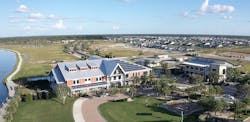Solar Energy Solutions Continue to Gain Momentum
Babcock Ranch is a sprawling master planned community on 18,000 acres on Florida’s West Coast, some 20 miles from Fort Myers, which prides itself on being “America’s first all-solar town.” Its marketing slogan is “We’re powered by the sun and energized by you.”
The power comes from 688,360 panels across 870 acres just north of town that provide electricity to the entire community. In development since 2006, Babcock Ranch was carved from 91,000 acres of wilderness of which 73,000 acres are now preserved under state control.
“The argument over what’s causing climate change doesn’t matter,” says Syd Kitson, president and CEO of Kitson & Partners, developers of Babcock Ranch. “Regardless of political or personal thoughts on it, [solar power is] the right thing to do, and Babcock Ranch is proving that.”
Notably, Babcock’s solar power is a cooperative venture with Florida Power & Light (FPL), the statewide utility that has historically relied on natural gas, coal, oil, and nuclear power to generate electricity for roughly 4.9 million accounts and 10 million people, but is increasingly harnessing sunshine as a source. With 18 major solar plants operating already, FPL has begun building 10 solar energy centers with a goal of 30 million panels installed and operating by 2030. This year, solar is outpacing coal and oil combined, as a percentage of the utility's energy mix (FPL shut down its last coal-fired plant in January, and is currently dismantling its oil plants).
Community Solar a Growing Trend
Babcock Ranch, which takes its name from the family that owned the land for generations, represents a marked evolution from the world of individual rooftop panels. It also reflects growing national interest—if not quite yet a trend—toward all-electric homes and community-wide solar.
“Fossil fuel people are starting to diversify, getting on the bandwagon with other energy sources,” says Jack Armstrong, a board member at Team Zero (formerly the Net Zero Energy Coalition), a group of industry stakeholders collaborating to bring broad industry-led national awareness of zero energy buildings.
The trend toward net-zero homes enabled by solar is accelerating in states that have adopted tax rebates and other incentives for community-wide installations. Among the leaders is Minnesota, which approved a solar garden initiative in 2013 and claims about one-third of the country’s community solar generation. Working with Cooperative Energy Futures (CEF), an investor in and supplier of solar-generated electricity, members typically buy a share of a common solar plot and in return get credits to reduce their electricity bills.
About the Author

Eugene L. Meyer
Eugene L. Meyer is an award-winning journalist and author and a former longtime reporter and editor at The Washington Post.

